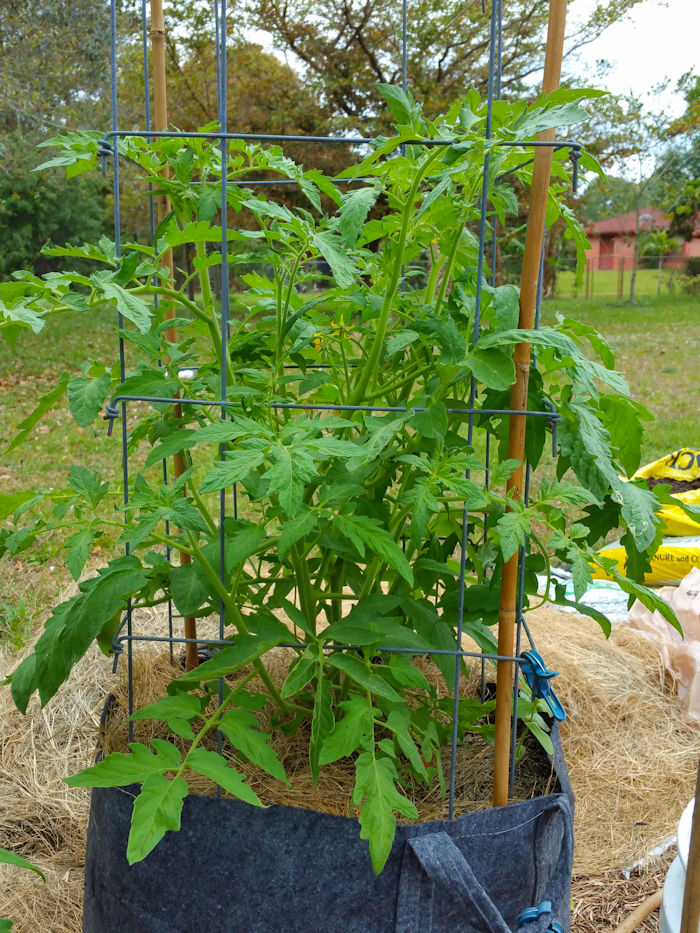Container Gardening and Tomatoes
Container gardening and tomatoes really do go together. After all, you will still give the plant what it needs — good soil, plenty of water, fertilizer (organic or not) and lots of sunshine.
You’ll just be doing it in a different place.
Containers 101
You can’t just grab any old container and stick your tomato plant in it — as the old saying goes, “size matters”. You need to consider the size of the plant versus the size of the container. Typically, the container measurement will be in gallons.
For a determinate tomato, you can usually get away with a 5-gallon container, although a 7 gallon is nicer, if you can get one. Since determinate tomatoes have a limited lifespan, they are usually smaller — and sometimes a lot smaller. For the itty-bitty plants, you could even use a 3 gallon pot.
When it comes to the indeterminate plants, container size does make a difference, between a decent enough harvest and a good harvest. Most indeterminate plants are pretty darn big (I’ve had Brandywines grow to 6 feet tall and 5 feet wide when I let them), so your container needs to reflect that.
For these hefty plants, I use containers anywhere from 15 gallons (for the smaller ones) up to 25 gallons for the Brandywine and Kellogg’s Breakfast tomatoes.
Yes, you can grow indeterminate tomato plants in smaller containers; but when you have a big plant, anything smaller than 12 gallons will definitely sacrifice some tomato production.
With the exception of indeterminate dwarf tomatoes — you can go with a 7 gallon container, and even a 5-gallon for a smaller dwarf.
The Dirt on Soil
One of the downsides of moving to an all-container garden is that I have to buy a lot of soil. Nope, I can’t just shovel what’s on the ground into my containers. For one, I’d have a lot of big holes in the yard, LOL. Second, it wouldn’t be great soil for the most part. My compost pile won’t fill all the containers — what’s a person to do?
And that is to drive on down to the lawn and garden center and buy lots of bags of compost and potting soil. And when it turns out I made a bad choice in potting soil, I have to turn around and buy some perlite, vermiculite and/or sphagnum moss to amend my bad choice.
And when I get all those (very heavy) bags home, I still have to get that soil into the containers. So yeah, it’s a pain to move from in-ground to container gardening all in one fell swoop. But if you’re just trying out a couple of containers to get your feet wet, it’s really not bad at all.
What’s in Your Potting Soil?
I have learned that not all bags labeled potting soil are created equal. Some are really nice, others not so much. What you have to remember is that your plants need to be able to drink and breathe. It’s an important topic, so I have a whole separate post talking just about soil for container gardens.
Have you ever watered a planter that was filled with sand? You know that maybe 15 minutes after watering it, the soil is dry again. This means you need to increase the water-holding capacity of sandy soils.
What about a clay soil — water it, come back tomorrow and it might still be “clay soup”. In this situation, you need to increase the drainage capability.
So, compost is first on my list of “necessary ingredients” in a good potting soil, because it can both increase water-holding for sandy soil, and help with drainage on clay-based soils. However, compost alone might make the soil too heavy. Enter perlite, which lightens the soil, to give the roots breathing room.
(BTW, perlite is a natural substance, as are its comrades vermiculite and sphagnum moss.)
My current favorite ready-made potting soil is from Vigoro, in the orange bags labeled as organic. Very nice consistency, if a bit on the pricy side. I don’t have to add anything to it — just pour it into the container and plant away!
Surprisingly, Miracle-Gro’s potting soil leaves a lot to be desired — it’s very heavy and the bags I got were full of sticks (not my idea of proper drainage). I like most of their stuff, but the potting soil is low on my “buy again next time” list. I have had to add perlite and sphagnum moss to lighten it up some. Plus, I am not all that crazy about all the fertilizer they include in it.
Mixing Your Own
I think I’ll stop for now, since this has gotten fairly long, and write up a separate entry for ideas on mixing your own potting soil. So until next time — keep on growing!
Leave a Reply